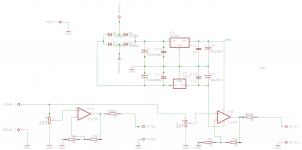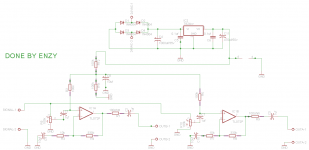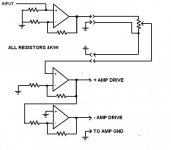I bought this amplifier on ebay and wanted to build a preamp to play it but I was wondering between a voltage follower and a preamp with a gain and some caps.
Assembled L30D 850W Digital mono amplifier board IRS2092 IRFB4227 IRAUDAMP9 LJM
I have uploaded both types of preamps my aim is to get max power out of the amplifier and the least amount of distortion.
Assembled L30D 850W Digital mono amplifier board IRS2092 IRFB4227 IRAUDAMP9 LJM
I have uploaded both types of preamps my aim is to get max power out of the amplifier and the least amount of distortion.
Attachments
thought I could get atleast one feedback or a I asking something which makes no sense.
I want to have ythe ability to control the volume of an amplifier which circuit would work best just the normal voltage follower or the other preamp.
I want to have ythe ability to control the volume of an amplifier which circuit would work best just the normal voltage follower or the other preamp.
I want to have the ability to control the volume of an amplifier which circuit
would work best just the normal voltage follower or the other preamp.
With 33dB of amplifier gain, just a 10k volume pot would be fine.
It only needs less than a volt for full output.
Stepped Attenuator / Volume Control 10K * D Shaft * ** Hi Fi Grade ** | eBay
Last edited:
I do not think you will need any gain. I use Nelson Pass' B1 v2. Easy to build, few parts. Be sure you build the version 2 if you decide on a buffer. Nothing wrong with a op amp buffer but J-fet is much better. IMHO and I have built many op amp buffers.
Of course, you have omitted important data: what will you drive it with?
If your music source provides more than 1V RMS output, just a pot will do, as suggested above; if less you´ll need some gain.
In any case , way less than what your examples show, the first one having 11X gain, the second one some 34X .
If your music source provides more than 1V RMS output, just a pot will do, as suggested above; if less you´ll need some gain.
In any case , way less than what your examples show, the first one having 11X gain, the second one some 34X .
With 33dB of amplifier gain, just a 10k volume pot would be fine.
It only needs less than a volt for full output.
At the output of the circuit there is a 1uf capacitor and the 100k pot which makes a high pass filter if I changed the pot to 10k wouldnt that block certain frequencies? Also what would be the advantage of using a 10k pot instead of 100k?
I do not think you will need any gain.
So what if my signal source puts out 1v RMS you said I wouldn't need any Gian so I would only use a pot, but wouldn't I need to turn the pot all the way clock wise to get full power?
If that's correct wouldn't it be better to have gain especially for songs that have low levels so that I can turn up, also isn't it the norm to have the volume pot at about half for full power without clipping?
At the output of the circuit there is a 1uf capacitor and the 100k pot which makes
a high pass filter if I changed the pot to 10k wouldnt that block certain frequencies?
Also what would be the advantage of using a 10k pot instead of 100k?
The pot value is a tradeoff between coupling capacitor size and high frequency roll off.
The 100k pot may work well in your case.
What I use with my TPA3116 PBTL...in a separate case.
Very quiet...even with DC-DC converters for power!
(one channel shown)
Very quiet...even with DC-DC converters for power!
(one channel shown)
Attachments
Last edited:
Why does one of your schematics use a dual supply, and the other a single. You're concerned about the 1ufd cap in the second one being a high pass filter. Why not use the dual supply and eliminate the cap altogether. Also as mentioned, your second schematic has way too much gain. You're almost into phono preamp territory. Your first schematic is not a voltage follower, it has gain too.
One more thing. The 24VAC is going to cause your regulators to get very hot. Your almost at the max for input voltage. Use an 18V CT transformer.
One more thing. The 24VAC is going to cause your regulators to get very hot. Your almost at the max for input voltage. Use an 18V CT transformer.
Why does one of your schematics use a dual supply, and the other a single. You're concerned about the 1ufd cap in the second one being a high pass filter. Why not use the dual supply and eliminate the cap altogether.
Im in practice now, I was getting aid from people of different beliefs so one was with a dual polarity concept and one was against it.
But I'll work with the dual polarity version and u added gain because in my mind I just think at some point I'll need gain but I didn't want to affect the signal in any way that's the reason I prefer that version using no caps.
I have always had an issue powering these small circuit in my projects, I always resort to buying a small transformer and building a simple linear power supply to run preamp and fans, for these amps I'm using a smps 70v, I tend to try using voltage dividers to run fans and preamps and even vu meters since I use the arduino to build a digital Vu meter but Im having power issues.
If I have a 70v power supply how do I know which wattage resistors to use so that I get enough power.
Say my fans pull 2 amps @12v that's 24w ignoring Pf. Using ohms law R= V/I =6ohms
Using a voltage divider I would step down from 70v to 30v using a 14k and a 10k resistor and send it to a 12v regulator if that can work how do u calculate which wattage resistors I would use?
If I have a 70v power supply how do I know which wattage resistors to use so that I get enough power.
Say my fans pull 2 amps @12v that's 24w ignoring Pf. Using ohms law R= V/I =6ohms
Using a voltage divider I would step down from 70v to 30v using a 14k and a 10k resistor and send it to a 12v regulator if that can work how do u calculate which wattage resistors I would use?
P = V * V / R
12V @ 2A would need to dump 58v @ 2A...116 watts, whether with resistors or linear regulator.
Imagine how hot a 100W light bulb gets.
Not the best solution.
Better (and takes up less space) is to get a small smps of 12V @ 2A.
12V @ 2A would need to dump 58v @ 2A...116 watts, whether with resistors or linear regulator.
Imagine how hot a 100W light bulb gets.
Not the best solution.
Better (and takes up less space) is to get a small smps of 12V @ 2A.
P = V * V / R
12V @ 2A would need to dump 58v @ 2A...116 watts, whether with resistors or linear regulator.
Imagine how hot a 100W light bulb gets.
Not the best solution.
Better (and takes up less space) is to get a small smps of 12V @ 2A.
OK thanks I only wanted to know for sure if anyone actually used that method to power the smaller loads
- Status
- Not open for further replies.
- Home
- Amplifiers
- Class D
- thoughts on preamp designs for class D amp


